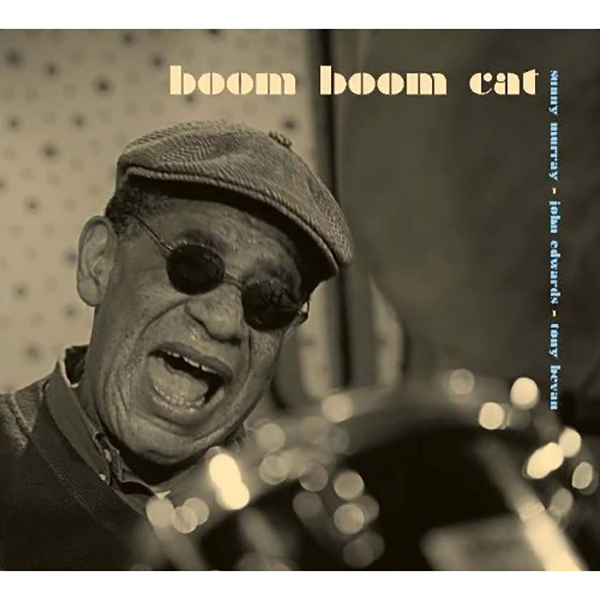
by Tim Owen
April 26, 2010
/ ALBUM
For anyone interested in the continuing state of free energy music it's near state of the art, and comes highly recommended.
Sunny Murray, John Edwards, Tony Bevan
“Boom Boom Cat”
(Foghorn Records)
Last year I reviewed one night of this trio’s concerts at The Vortex in Dalston, London. This new CD was recorded at the same venue on 1st September, just a few days later. It consists of just two pieces. The title track, Boom Boom Cat, comes in just shy of an hour. An encore, Ballad for G, is a mere thirteen minutes.
From the start Murray is insistently riding the ride cymbal, and though this set has it’s moments of light and shade it’s pretty consistently full on. The album title and its cover shot of Murray in flat cap and shades might seem to reference classic 60s west coast or Blue Note album covers, which may mislead some buyers; this album is squarely in the Impulse!/ESP fire music tradition.
Murray’s activity is ceaseless and stylistically constant. He’s not the most stylistically variable of drummers, but curiously this doesn’t limit his adaptability. Most importantly, he’s an absolute master of tension and release. At roughly the 36 minute mark, to take an example almost at random, the trio gradually slow the pace before Edwards and Bevan lay out to allow Murray to solo for a few minutes. Only it’s not a drum solo as such, not an opportunity the drummer to show us his chops, just an chance for Murray to relax a little and in doing so to emphasise just how musical, despite the narrow stylistic parameters, his rhythmic conception is, and just how expansive and inclusive the constant flow of his invention.
A highlight for me, 20 minutes into the title piece, has Bevan on soprano sax, his tone acerbically beautiful in the face of Murray’s cloudburst drum rolls and Edwards’ thunderously thrumming bass. Edwards carries the momentum as Murray eases off, and Bevan grabs the opportunity to switch to baritone for a gruffer variation on a similar line of development. Edwards is particularly responsive on this date. In set ups where the lead is taken by a powerhouse saxophonist he can at times be too readily combative, but Bevan is never all about lung power, and with Murray setting the pace and effectively dictating how pressurised things can get, Edwards has to be even more imaginative and resourceful than usual, working to buttress and embellish Murray’s contributions from the inside.
Murray is up and at the relatively short coda, Ballad for G, before Edwards and Bevan sound quite ready, but he takes it at a nonchalant swing with some lovely brushwork. On baritone Bevan sounds particularly soulful, but as the track ebbs and surges it grows in intensity and Bevan’s tone becomes almost anguished. The end, when it comes, is positively liberating.
This set must have been exhausting for the audience to experience, let alone for the trio to play. Clearly, as suspected, I’d earlier caught the group on an off night. It’s a shame that the unrefined production of this recording (for many free jazz addicts, of course, this is a bonus) and the daunting length of its tracks might limit the audience for this album, because for anyone interested in the continuing state of free energy music it’s near state of the art, and comes highly recommended.
blog comments powered by Disqus